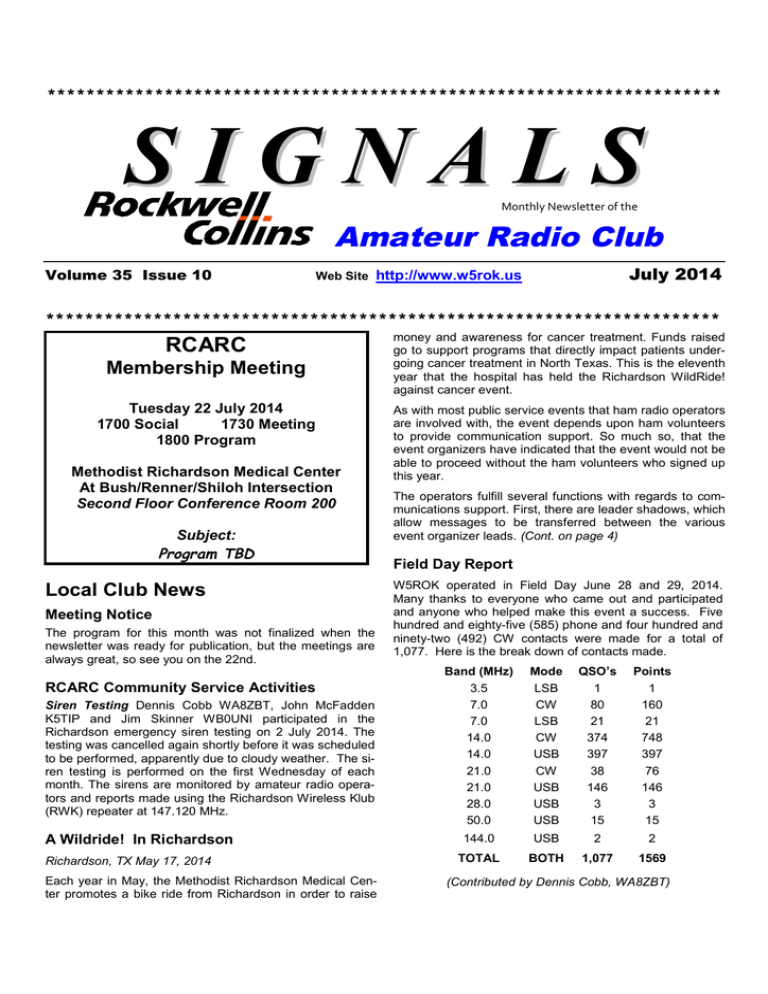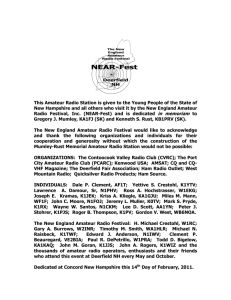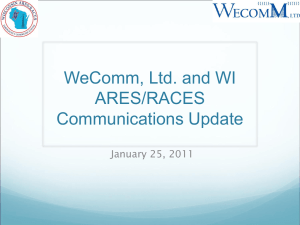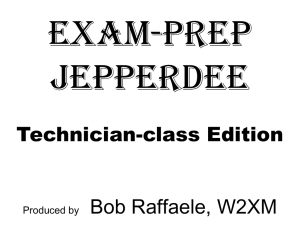July 2014 - Rockwell Collins Amateur Radio Club
advertisement

********************************************************************* SIGNALS Monthly Newsletter of the Amateur Radio Club Volume 35 Issue 10 Web Site July 2014 http://www.w5rok.us ********************************************************************* RCARC Membership Meeting Tuesday 22 July 2014 1700 Social 1730 Meeting 1800 Program Methodist Richardson Medical Center At Bush/Renner/Shiloh Intersection Second Floor Conference Room 200 Subject: Program TBD Local Club News Meeting Notice The program for this month was not finalized when the newsletter was ready for publication, but the meetings are always great, so see you on the 22nd. RCARC Community Service Activities Siren Testing Dennis Cobb WA8ZBT, John McFadden K5TIP and Jim Skinner WB0UNI participated in the Richardson emergency siren testing on 2 July 2014. The testing was cancelled again shortly before it was scheduled to be performed, apparently due to cloudy weather. The siren testing is performed on the first Wednesday of each month. The sirens are monitored by amateur radio operators and reports made using the Richardson Wireless Klub (RWK) repeater at 147.120 MHz. A Wildride! In Richardson Richardson, TX May 17, 2014 Each year in May, the Methodist Richardson Medical Center promotes a bike ride from Richardson in order to raise money and awareness for cancer treatment. Funds raised go to support programs that directly impact patients undergoing cancer treatment in North Texas. This is the eleventh year that the hospital has held the Richardson WildRide! against cancer event. As with most public service events that ham radio operators are involved with, the event depends upon ham volunteers to provide communication support. So much so, that the event organizers have indicated that the event would not be able to proceed without the ham volunteers who signed up this year. The operators fulfill several functions with regards to communications support. First, there are leader shadows, which allow messages to be transferred between the various event organizer leads. (Cont. on page 4) Field Day Report W5ROK operated in Field Day June 28 and 29, 2014. Many thanks to everyone who came out and participated and anyone who helped make this event a success. Five hundred and eighty-five (585) phone and four hundred and ninety-two (492) CW contacts were made for a total of 1,077. Here is the break down of contacts made. Band (MHz) 3.5 7.0 7.0 14.0 14.0 21.0 21.0 28.0 50.0 Mode LSB CW LSB CW USB CW USB USB USB QSO’s 1 80 21 374 397 38 146 3 15 Points 1 160 21 748 397 76 146 3 15 144.0 USB 2 2 TOTAL BOTH 1,077 1569 (Contributed by Dennis Cobb, WA8ZBT) SIGNALS July 2014 month at St. Barnabas Presbyterian Church, 1220 West Beltline Rd. Testing begins at 1900 hrs in room 12. Enter through the Northern most door on the east side of the church building. For further information contact Dave Russell W2DMR, at 972.690.9894 or E-mail warhog4 @tx,rr.com. RCARC OFFICERS PRESIDENT Dennis Cobb 972.705.1464 VICE-PRESIDENT WA8ZBT ddcobb@rockwellcollins.com Bob Kirby 319.360.0500 k3nt@arrl.net SECRETARY TREASURER Jim Brown AF5MA 972.495.2209 jhksbrown@verizon.net Mike Montgomery WD5TX 972.705.1498 dmmontgo@rockwellcollins.com . ACTIVITIES K3NT WEBSITE MANAGER OPEN Mike Hollingsworth 972.571.6060 w5qh@arrl.net W5QH STATION TRUSTEE NEWSLETTER EDITOR Steve Phillips 972.517.3332 k6jt@arrl.net Jim Skinner 214.535.5264 wb0uni@arrl.net K6JT DATABASE MGR Joe Wolf 972.705.1388 n5uic@arrl.net S I G N A L S is the monthly newsletter of the Rockwell Collins Amateur Radio Club, published by and for its members. The entire contents of this newsletter are copyright 2014 by the Rockwell Collins Amateur Radio Club. Permission is hereby granted to any not-for-profit amateur radio publication to reprint any portion of this newsletter provided both the author and Rockwell Collins Amateur Radio Club are credited. President’s Message WB0UNI The Rockwell Collins ARC had its annual Field Day again this year. We operated class 1D. It was a good test of the new Elecraft KPA-500 Amplifier. A lunch was provided on Saturday Night. I would like to thank everyone who helped make this event possible. W5ROK CLUB STATION N5UIC 972.705.1349 461-290 July 17, 2014 was the yearly “Bring your kids to work Day”. We had about 25 to 30 Kids show up to see our “ Shack”. Everyone was having a good time. The weather that morning made for a nice display on the TV. Mike Schmit was showing kids PSK31 communications, SSB reception and also having a few talk on the 440 Repeater. I would like to thank Mike Schmit, WA9WCC and John McFadden, K5TIP for helping make this possible. If there is anyone else I forgot thanks for your help also. VE SESSIONS Dallas tests are held 4th Sat of each month at 1000 hrs. 13350 Floyd Rd. (Old Credit Union) Contact Bob West, WA8YCD 972.917.6362 Irving tests are held 3rd Sat of each month at 0900. Fifth and Main St. Contact Bill Revis, KF5BL 252-8015 McKinney VE test sessions are held at the Heard Museum the first Sunday of the month. The address is 1 Nature Place, McKinney TX. The time of the testing is 1430, ending no later than 1645. Note: no tests given on holiday weekends. That is about it for this month. The meeting is Tuesday July 22, 2014. See you there. 73, Dennis Cobb WA8ZBT RCARC President Garland testing is held on the fourth Thursday of each month, excluding November, and begins at 1930 sharp. Location is Freeman Heights Baptist. Church, 1120 N Garland Ave, Garland (between W Walnut and Buckingham Rd). Enter via the north driveway. A HUGE parking lot is located behind the church. Both the parking lot and the Fellowship Hall are located on the east side of the church building, with big signs by the entrance door. Contact Janet Crenshaw, WB9ZPH at 972.302.9992. Plano testing is on the third Saturday of each month, 1300 th hrs at Williams High School, 1717 17 St. East Plano. Check Repeater 147.180+ for announcements. Greenville testing is on the Saturday after 3rd Thursday, 1000 hrs at site TBA, contact N5KA, 903.364.5306. Sponsor is Sabine Valley ARA. Repeater 146.780(-) with 118.8 tone. Richardson The Richardson Wireless Klub (RWK) VE team hold license testing on the third Thursday of each 2 SIGNALS July 2014 been installed and is operational. This board was also purchased at Ham-Com. Secretary's Report 24 June 2014 New Business: Dennis Cobb announced that N1MM contest software has been installed on the RCARC P3 in preparation for Field Day. The meeting was called to order by President Dennis Cobb WA8ZBT at 1742. The following members and guests were present at the meeting: Jim Brown AF5MA Dennis Cobb WA8ZBT Adjournment: Following general discussions on future meeting topics and beacon transmitters, the meeting was adjourned at 1810. The next meeting will be at 1730 on Tuesday, 29 July 2014. Kathy Cobb Bob Kirby K3NT Mike Schmit WA9WCC Jim Skinner WB0UNI Joe Wolf N5UIC The $11 spectrum analyzer & SDR Michael Dunn-June 28, 2014 If I offered you the secret to the $11 spectrum analyzer & software-defined radio, what would you promise me? Your firstborn? Treasures of gold and diamonds. Well, I'll consider the latter. Here it is. Officers and Committee Reports: President's Report: See under Old Business below. Vice-President's Report: Bob Kirby K3NT reported on his activities in support of the current tour of FiFi, including radio operations out of Prescott, Arizona. Press reports have been very good, and flights on FiFi have been booked over the air. Secretary's Report: The Secretary's Report is in this newsletter. Treasurer's Report: In the absence of the Treasurer, President Dennis Cobb reported the RCARC treasury balance. The figure as reported was accepted by a vote of members present. Website Manager's Report: There was no Website Manager's Report. Station Trustee's Report: There was no Station Trustee's Report. Database Manager's Report: Manager's Report. OK, it may not be news to some of you, but for everyone else, here's a USB tuner you can buy from "China Inc." for about $10-$13 shipped (see eBay, DX, etc.), that'll give you 24MHz to 1.766GHz coverage, regardless of whether you want to analyze spectra, or just listen to the radio. There was no Database Old Business: President Dennis Cobb WA8ZBT announced a number of actions: The USB dongles in question contain a Realtek RTL2832U (ADC, USB, and demodulators) and a Rafael Micro (who?) R820T tuner chip. Here are the innards. 1. The Weather Picture wall display by Peet Brothers is up and running in the RCARC radio shack. We have approval from Rockwell Collins to mount the display outside the shack, and a maintenance request will be generated for the installation. I'd originally heard of an Android app that worked with this dongle, but I wasn't able to get it working on my no-name tablet. Fortunately, even better software can be had for real computers. Here's a screenshot of Gqrx while I'm listening to my local CBC station: 2. The Pixel Technologies magnetic loop antenna as previously approved has been installed on the roof and connected to the ham shack. The antenna was purchased at Ham-Com at the Plano Centre for $400. The sound quality is very good, should that be your interest. 3. The P3 SVGA board for the Elecraft K3/P3 transceiver, also approved by the membership, has also 3 SIGNALS July 2014 15kHz FM at around 180MHz – Gqrx If spectra are more your thing, here are some signals from an RF generator. For reference, I've included displays from my Tek MDO3000 in SA mode. The correlation is good! 15kHz FM at around 180MHz – Tek MDO3000 If this is old-hat for you, what have your experiences been on the SA & SDR fronts? Software links: 15kHz AM at around 180MHz – Gqrx Gqrx software defined radio receiver OS X port of the awesome gqrx SDR software Download links for Gqrx SDR OsmoSDR (Editors Note: readers of this article may find useful comments by going to the EDN site at http://edn.com/electronics-blogs/benchtalk/4431768/The-11-spectrum-analyzer---SDR?_mc=NL_EDN_EDT_EDN_ designideas_20140701&cid=NL_EDN_EDT_EDN_design ideas_20140701&elq=c2de039f46f344d590e181cb235b8d 0b&elqCampaignId=17803). (Reprinted courtesy of Michael Dunn and EDN.com) 15kHz AM at around 180MHz – Tek MDO3000 4 SIGNALS July 2014 – MT65-2000 in this event. The setup is fairly simple and provides clear and good communications over long distances using either 2m or 70cm transceivers. In our case, we setup a 70cm station and were able to connect with W5ROK repeater, which is about 30 miles away. The station consisted of a Yaesu FT-7900R, a home-brew audio interface with transformer isolation on both input and output audio, along with RS232 PTT control using optoisolation. The antenna, a high-gain dual band VHF/UHF antenna, was hoisted about 20 feet in the air using a telescoping flagpole, complete with US flag. The system, including power supply and laptop running FlDigi software, was supported by a folding table under a pop-up canopy. AC Line voltage was provided by my Camry Hybrid battery using an inverter. This provided voltage for both the laptop and the 12volt power supply for the rig. The plans were to also establish an HF radio station, which did not materialize due to the fishing line breaking and complications with the antenna site. A Wildride! In Richardson (Continued from page 1) Second, there are rest stop operators who pass rest stop needs and important information back to the organizers and other logistic support personnel. Thirdly, there are rest stop operators who observe and pass less critical information from the rest stops to the organizers. Fourthly, there are operators who work in SAG vehicles and are dispatched to rescue stranded riders and transport them back to the start/finish area. Fifthly, there are liaison operators who are stationed with either Emergency Medical Service vehicles or vehicles operated by local bicycle shops in order to help with logistics when help is needed. This year, as in the last several years, Doug Kilgore – KD5OUG, has been organizing the event. This year, how- ever, Doug has to be out of town for this year’s event. After accomplishing most of the organization work, Doug passed the baton to Michael Griego – N5GNU, who ran with the program through to a good success. John Galvin – N5TIM covered Net Control for the main net. We had various trackers installed in ancillary vehicles provided by Chadwick Stelzl – KD5UMO. We had two lead/tail vehicles this year and ten SAG vehicles. With four rest stops covered by a total of fifteen ham operators, every base was now covered. NBEMS operations using FlDigi is quite robust, when including FlMsg, which can format the message into many of the ICS forms that are used. FlMsg can also pass binary data, such as a picture or file attachment. In some cases, a spreadsheet is sent with information on it. This can be useful in the field in order to accumulate and share data. FlDigi configuration is the key to operating a successful NBEMS station. Extra care is taken to insure everyone is operating with the same settings. Tests are performed to insure we can accurately pass information back and forth without issue. Training is performed a few months leading to the event, as well as all year round via the Dallas NBEMS net, which meets on the first and third Wednesday nights at 7:30pm on the K5RWK repeater. There is a yahoo group for the Dallas NBEMS group called “dalNBEMS”. Jim (W5OMG) and Amelia (KD5TXQ) Shultz established their voice station next to the digital station. For this writer and ham operator, I operated a digital station at Rest Stop #3, located in Josephine, TX. I was accompanied by Chris Havenridge – KF5GUN. We had a good time setting up the station and we spent a good amount of time discussing NBEMS and APRS details, besides passing some traffic now and then. Rest Stop #3 was also assigned to Jim and Amelia Shultz – W5OMG and KD5TXQ, respectively. Jim ran voice traffic for any urgent needs for the rest stop. Chris Havenridge Sr (KF5GUN) & Michael Ketchum (K5MDK) at Rest Stop #3 The audio/PTT interface that I built provides audio isolation so that noise and RF cannot enter into the computer’s sound card. This is accomplished through isolation transformers placed between the laptop and radio for Digital communications was utilized again this year for the fourth year in a row. This was my third year using NBEMS 5 SIGNALS July 2014 both the input and output audio. The laptop’s sound card is not used for NBEMS operation so that no windows noise and audio levels can be controlled more accurately. Instead, a USB sound card is used, which allows the audio settings to be uniquely controlled for NBEMS operations, without the need adjusting audio levels. Also, there is no fear of “you’ve got mail” or a windows sound going out over the air, as the built-in sound card is always configured to handle those kinds of notifications. The PTT control is done through an RS232 interface, which allows an opto-isolation device to control the radio’s transmit controls. FlDigi can be configured to control PTT via the RS232 com port. Another USB RS232 adaptor is used to provide this interface to the radio. The interface and all of the components are wired to the radio using the radio’s external speaker connector (1/8” phone jack) as well as the microphone connector (RJ-22), which I put together using the radio’s technical manual for a wiring guide. New hams are different By Dan Romanchik, KB6NU This is going to be a bit of a ramble, but I need to get some thoughts down about new hams, and maybe get some feedback on these ideas from both new hams and guys that have been around for a while. Recently, I visited the All Hands Active (AHA) makerspace here in Ann Arbor. Several of the "makers" that use this space have recently gotten their ham licenses—-most of them in one of my one-day Tech classes. I was down there trying to get them interested in attending Field Day, and in particular, in operating the GOTA station. There were four of us sitting around, talking about amateur radio, the projects they were working on, Field Day, and other stuff. In the past, they had also expressed an interest in doing something with WA2HOM, our station at the Ann Arbor Hands-On Museum. While it was a great discussion, it was apparent to me that it was going to be difficult to get them out for Field. The components were all tested here at my home QTH by joining the Dallas NBEMS net in Richardson. I had a great signal report from Greenville to Richardson on both digital as well as voice, a 41 mile trip. On the net, we would test our connections, exchange graphic files, ICS messages and other assignments. One of the new assignments this year was the US National Grid System, a coordinate system that provides various degrees of accuracy as well as simple distance calculation formula that can be done with a calculator, as opposed to using complex math. It dawned on me that these new radio amateurs were just not interested in the “old” amateur radio. Sitting in front of shortwave radios and exchanging fake signal reports with other guys sitting in front of shortwave radios is just not their idea of a good time. I think that if you take a step back and try to look at it through their eyes, you’ll see where they’re coming from. What are they interested in? Well, one guy is having a blast playing around with RTL SDR dongles. He’s also trying to figure out a way to rig up wireless link to light a light at bus stops around his house when a bus is approaching. Another is working on a Hinternet-type project. I helped him out a little bit last summer setting up a wireless node at his house. This is perhaps one reason why there are so many more licensed radio amateurs these days, but yet there seems to be less activity on the HF bands these days. HF is just not where it’s at for these new guys. One consequence of this is that the old amateur radio clubs don’t have much to offer the new guys. In fact, one of them told me that the one time that he attended the local club meeting, he got such a hostile response that he decided not to return. Many thirsty riders refuel before finishing the 64-mile WildRide! against cancer. I’m finding this all quite interesting. I do intend to pursue some kind of joint activities between the All Hands Active maker group and WA2HOM and see where that goes. They may not be interested in working DX on 20m, but they do seem to be interested in the IRLP node that we’re in the process of installing there. The Wild Ride, itself, was uneventful, which was a blessing. We had no major injuries this year, which is a sharp contrast to last year’s event. The event organizers were very pleased with the ham radio volunteers again this year. Chris – KF5GUN and I had a great time. In retrospect, we had too much technology discussions and work to do to involve HF communications on top of all of that. It worked out for the better that we did not have the resources to setup the HF station. I’m not sure where this is all headed, but what I do know is that these folks have a lot of energy and creativity. If we can couple that with our knowledge and experience, then I think that we’ll be a good fit for one another. It’s going to take open minds all around, though. (Article contributed by Michael Ketchum, K5MDK) 6 SIGNALS July 2014 I'm really interested in hearing from all of you about this. Have your clubs made contact with the "makers" in your area? Do any of them have ham radio licenses? Are there any interesting ham radio/maker projects going on in your area? Upcoming Events AUGUST 2-3 August UHF Contest. Objective: To work as many amateur stations in as many 2 degrees by 1 degrees grid squares as possible using authorized amateur frequencies above 222 MHz and all authorized modes of emission. 16-17 10 GHz and up Contest. The objective of 10 GHz and Up is for North American amateurs work as many amateur stations in as many different locations as possible in North America on bands from 10-GHz through Light. Amateurs are encouraged to operate from more than one location during this event. =========================================== When he's not thinking about the future of amateur radio, Dan, KB6NU enjoys working CW on the HF bands, teaching amateur radio classes, and building kits. For more information about his operating activities and his "NoNonsense" series of amateur radio license study guides, go toKB6NU.Com or e-mail cwgeek@kb6nu.com. (Contributed by Frank Krizan, KR1ZAN) AMSAT Fox-1C Launch nounced Opportunity An- AMSAT is excited to announce a launch opportunity for the Fox-1C Cubesat. AMSAT has teamed with Spaceflight Inc. for integration and launch utilizing Spaceflight's SHERPA system to a sun-synchronous orbit in the third quarter of 2015. SEPTEMBER 13-5 September VHF Contest. Objective: for amateurs in the US and Canada (and possessions) to work as many amateur stations in as many different 2 degrees x 1 degree Maidenhead grid squares as possible using authorized frequencies above 50 MHz. Stations outside US & Canada (and possessions) may only work stations in the US (and possessions) and Canada. 20-21 10 GHz & Up Contest–Round 2: The objective is for North American amateurs to work as many amateur stations in as many different locations as possible in North America on bands from 10-GHz through Light. Amateurs are encouraged to operate from more than one location. Please consider a recurring, club, or corporate donation to maximize our chance of success with this mission. Also watch our website at www.amsat.org,follow us on Twitter at "AMSAT", or on Facebook as "The Radio Amateur Satellite Corporation" for continuing news and opportunities for support. AMSAT is a 501(c)3 non-profit corporation and donations may be tax-deductible. Daily DFW Early Traffic Net (NTS) at 6:30pm 146.88 – PL 110.9Hz Daily DFW Late Traffic Net (NTS) at 8:30pm 146.72 – PL 110.9Hz Daily DFW CW Traffic Net (NTS) at 7:00pm and at 10pm on 3541 KHz www.k6jt.com From AMSAT News Service, Bulletin ANS-199, dated 18 July 2014. [ANS Thanks AMSAT Board of Directors for the above information] 1 Wednesday (Courtesy ARRL News Bulletin, ARLB015, dated 28 June 2014) Fox-1C is the third of four Fox-1 series satellites under development, with Fox-1A and RadFXsat/Fox-1B launching through the NASA ELANA program. Fox-1C will carry an FM repeater system for amateur radio for use by radio hams and listeners worldwide. Further details on the satellite and launch will be made available as soon as released. AMSAT has an immediate need to raise funds to cover both the launch contract and additional materials for construction and testing for Fox-1C. We have set a fundraising goal of $125,000 dollars to cover these expenses over the next 12 months, and allow us to continue to keep amateur radio in space. Donations may be made through the AMSAT webpage at www.amsat.org, by calling (888) 322-6728 or by mail to the AMSAT office at 10605 Concord Street, Kensington, MD 20895, USA. REGULAR ACTIVITIES (Contributed by Frank Krizan, KR1ZAN) 7 st Richardson Emergency Siren Test. At noon using the Richardson Wireless Klub (RWK) repeater at 147.120 MHz. 2 Wednesday nd ARES North Texas HF Net Every month— 3860 KHz at 830 pm—930pm Thurs day Sabine Valley Amateur Radio Association Net Every Thursday night at 7:00pm on the K5GVL/R 146.780 MHz (+) PL 114.8Hz SIGNALS July 2014 Rockwell-Collins Amateur Radio Club Mail Station 461-290 P.O. Box 833807 Richardson, TX 75083-3807 TO: CLUB STATIONS (972) 705-1349 W5ROK REPEATER 441.875 MHz +5 MHz Input 131.8 Hz PL - RX and TX W5ROK-1 PACKET BBS ROK Node 145.05 MHz W5ROK-N1, W5ROK-N2 & W5ROK-N3 HSMMMESHNET Nodes 2.4 GHz Tuesday 22 July 2014 1700 Social 1730 Meeting Methodist Richardson Medical Ctr At Bush/Renner/Shiloh Intersection Second Floor Conference Room 200 NEXT SIGNALS INPUTS DEADLINE: 15 August 2014 8


